Grocery Hacks to Save Hundreds Per Month
Groceries are one of those unavoidable expenses—you have to eat. But if you’re swiping your card at checkout and wincing every time, you’re probably spending way more than you need to.

The truth is, most people overspend on food without realizing it. They make small, costly mistakes every week that add up to thousands per year. The good news? You don’t have to sacrifice quality to save money. In fact, with the right grocery hacks, you can eat just as well—if not better—while cutting your bill by 30% or more.
Let’s break down the best grocery-saving strategies that will leave you with more money in your pocket and no regrets in your fridge.
The #1 Rule: Stop Buying Like Everyone Else
If your grocery shopping strategy is just walking into the store, grabbing what looks good, and hoping the total isn’t too bad at checkout, you’re already losing the savings game.
Grocery stores are designed to trick you into spending more. That’s why the essentials—milk, eggs, bread—are always at the back of the store, forcing you to walk past dozens of tempting items before you reach them. It’s why those “limited-time” promotions feel urgent, even though they happen every other week.
The key to saving? Breaking the cycle of impulse shopping. The people who save the most don’t just buy whatever catches their eye—they have a strategy before they even step foot in the store.
Hack #1: Meal Plan Like a Pro (But Keep It Flexible)
Most people shop without a plan, which leads to overbuying, wasted food, and forgotten ingredients that sit in the fridge until they expire.
The easiest way to avoid this is by planning your meals in advance. But before you picture a rigid spreadsheet dictating what you eat every night, here’s the trick: meal planning works best when it’s flexible.
Instead of locking yourself into an exact menu, plan four or five meals for the week and leave room for leftovers. Rather than picking meals randomly, check what’s on sale first and build your meals around that. If chicken is cheap this week, plan chicken-based meals. If ground beef is overpriced, skip it and go for an alternative.
This simple adjustment—letting the store’s deals guide your menu—can instantly cut your grocery bill by 20% while keeping your meals high quality.
Hack #2: Shop with a List—And Stick to It
Have you ever gone to the store for “just a few things” and walked out $100 lighter? You’re not alone. Grocery stores are designed to make you spend more.
The solution is simple: always shop with a list—and more importantly, stick to it.
When you plan your meals in advance, your list becomes your roadmap. If an item isn’t on your list, it doesn’t go in your cart. It’s not about depriving yourself; it’s about eliminating unnecessary spending.
But sticking to a list doesn’t just prevent impulse buys—it also reduces waste. You’ll only buy what you need, meaning fewer forgotten vegetables rotting in the crisper drawer.
People who shop with a list spend 30% less than those who don’t. It’s one of the easiest ways to cut down your grocery costs without changing what you eat.
Hack #3: The Secret to Saving on Meat (Without Going Vegetarian)
Meat is one of the biggest expenses on most grocery bills, but you don’t have to stop eating it to save money. Instead, adjust how and when you buy it.
Buying in bulk is one of the best ways to save. Family packs of chicken, beef, and pork are significantly cheaper per pound than smaller packages. If you don’t need all of it right away, just freeze what you won’t use.
Another trick is choosing cheaper cuts that are just as good—sometimes better—than the premium options. Chicken thighs are often half the price of chicken breasts and have more flavor. Pork shoulder costs far less than pork chops and is incredibly versatile. Even beef chuck roast can be transformed into tender, flavorful meals for a fraction of the cost of a steak.
And don’t overlook the markdowns. Stores discount meat that’s nearing its sell-by date, often by 30% or more. If you plan to cook or freeze it that day, you just got a huge discount without sacrificing quality.
Tweaking when and how you buy meat can save you $20–$40 per trip without making any real sacrifices.
Hack #4: Ditch Name Brands (Most of the Time)
Brand loyalty is costing you money. Store-brand groceries are often identical to name brands—sometimes even made in the same factories.
There’s a common misconception that store brands are lower quality, but in reality, they’re often the same product with different packaging. This is especially true for pantry staples like flour, sugar, canned goods, pasta, and dairy.
Some items—like soda and chips—might taste different, but for most basic groceries, the only real difference is the price. Switching to store brands can instantly slash your grocery bill by 20–30%.
Hack #5: Use Cashback & Grocery Apps
Why pay full price when grocery apps pay you back for buying the same items?
Here are some of the best apps to stack savings:
- Ibotta – Earn cashback on everyday grocery purchases.
- Fetch Rewards – Scan receipts and earn points for gift cards.
- Rakuten – Get cashback when buying groceries online.
Using these apps consistently can lead to an extra $20–$50 a month in savings—just for scanning receipts.
Hack #6: Know When & Where to Shop for the Best Deals
Timing your grocery trips can make a huge difference in what you pay. Many stores follow predictable discount patterns, meaning you can shop strategically to get the best prices.
For example, early mornings and late evenings are the best times to find markdowns, especially on meat and bakery items. Midweek shopping—particularly on Wednesdays and Thursdays—lets you catch fresh markdowns before the weekend rush.
And at the end of the month, many stores drop prices to clear inventory, giving you another opportunity to stock up for less.
Understanding these timing tricks can cut your grocery costs by an extra 10–20%.
The Grocery Budget Breakdown: How Much Should You Actually Spend?
A good rule of thumb is that your grocery bill should be 10–15% of your monthly income. If you’re spending significantly more than that, you’re likely leaving a lot of savings on the table.
Example Monthly Grocery Budgets by Income Level:
| Household Income | Suggested Grocery Budget |
|---|---|
| $3,000/month | $300 - $450 |
| $5,000/month | $500 - $750 |
| $8,000/month | $800 - $1,200 |
If your grocery bill is way above these numbers, there’s room for big savings using these hacks.
Final Thoughts: The Secret to Cutting Grocery Costs Without Sacrificing Quality
Most people don’t realize how much money they waste on groceries—buying random items without a plan, paying for name brands unnecessarily, and shopping without strategy.
But by shifting how you shop, when you shop, and what you buy, you can cut your grocery bill by hundreds each month—without feeling deprived.
